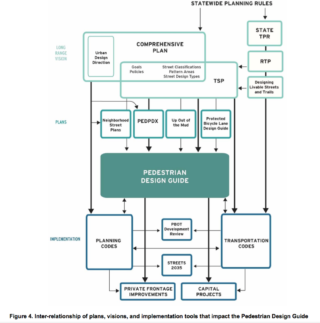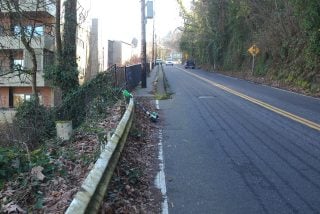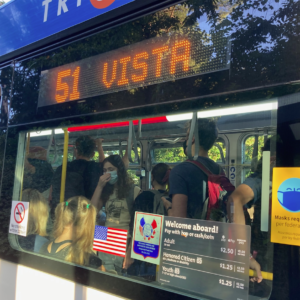
In Portland we drink from the punch bowl called Planning — the 2035 Comprehensive Plan, the Bicycle Plan for 2030, PedPDX, and the various “in Motions” (north Portland being the latest). The Portland Bureau of Transportation (PBOT) Planning department also has a hand in large capital projects funded by the public which showcase our transportation values, like the Ned Flanders pedestrian and bike bridge and the SW Capitol Highway Project to name a couple.
So it’s understandable that many of us think Portland’s transportation network gets built with capital projects guided by Planning.
But there’s another important PBOT department which gets less attention from transportation activists, it’s called Reality Check — I mean, Development Review. They work with private developers to ensure that private right-of-way and frontage work meets code and various guidelines and standards. City ordinance requires frontage improvements as part of development, and many of the city’s sidewalks and frontages have been built privately, so Development Review is an important group that can pass under the radar.
The folks at Development Review have a stressful job. They are the interface between transportation advocates and neighborhood associations (who have suckled on the steady flow of aspirations from Planning) and private developers who may not want to be on the hook for the bill.
Looking the problems square-on is the first step to solving them.
This natural tension between Planning and Development Review is one lens through which to view the long-awaited Pedestrian Design Guide (PDG) update, which is due any day now. The PDG is the city’s “primary guidance on how sidewalks should be built throughout Portland to ensure they are context-appropriate and accessible to people of all ages and abilities,” and it was last updated 23 years ago. Since that time, Portland has grown by 100,000 people and “additional plans, policies and procedures . . . make implementing the PDG confusing for staff.” Hence the current update.
While awaiting the PDG release, I have found myself buried in a fascinating memorandum on the project website titled, the Pedestrian Design Guide Focus Group & Peer City Review Memo. It’s a straightforward document written by the transportation consultants Toole Design for the planners tasked with updating the PDG. If you want an unadulterated view into the mind of a bureaucracy, this is it.
The document falls into two sections: focus group summaries from the various in-house users of the PDG, and reviews of five peer cities (Seattle, Washington DC, Denver, Boston and Austin), “to get a sense of how other cities are working to create their ideal sidewalk corridors.”
Development Review is the primary customer of the PDG, and their focus group lays bare the tight space they navigate between transportation ideals and what improvements they can ask developers to make. They request the city “make a side effort to ‘sunset’ any outdated rules or policies to ensure that there would not be any conflicts that could be cited by developers.”

They also ask for “flexibility” when trade-offs need to be made. Development Review often finds itself between a hard place (like a basalt rock face) and a gulch, where the ROW is “constrained,” especially in southwest Portland. The cliff/gulch topography characterizes and constrains most of SW Portland’s main corridors. In practice, the “flexibility” to deal with local conditions sometimes leads to reducing active transportation requirements to pro forma nods toward safety, which don’t actually make the roadway safer for people riding or walking.
The questions are: What will the new Pedestrian Guide recommend in these constrained situations? How committed is Portland to making sure that everyone can use the right-of-way safely and comfortably, including those on foot and bike? What will it recommend for narrow residential roadways?
I’m optimistic. It is a welcome step forward to read documents that don’t shy away from the big issues of stormwater management, legal vulnerability, exceptions to ADA requirements and need for context-sensitive design. Looking the problems square-on is the first step to solving them.

— Lisa Caballero, lisacaballero853@gmail.com
— Get our headlines delivered to your inbox.
— Support this independent community media outlet with a one-time contribution or monthly subscription.






Thanks for reading.
BikePortland has served this community with independent community journalism since 2005. We rely on subscriptions from readers like you to survive. Your financial support is vital in keeping this valuable resource alive and well.
Please subscribe today to strengthen and expand our work.
The Pedestrian Design Guide updates (coming out for public comment any day now) will also include a potentially valuable toolkit to carve out space for walking and rolling on smaller streets without sidewalks, which are common in East Portland and SW. One important part of making those work is using stripes, wands, planters or other furniture to narrow the portion ordinarily traveled by vehicles to 18′ or narrower, which results in much lower speeds (legally and practically) and opens up a wide range of options for safe space.
One has to wonder, if government planners would spend more time doing, than planning, how much further along we might be with partial work already done to help reduce issues that the region is facing.
It just seems like all the planners want the “perfect” plan. Why not get an initial plan going and modify it as you go?
I know, I’m just crazy to think that way.
Hi SolarEclipse,
I hear you with plans on top of plans, but this work does not strike me that way.
This is largely an internal document for various PBOT departments. The Development Review people work autonomously, they don’t go running to the planners every time someone wants to build a new house, so they need up-to-date guidance for the project-by-project decisions they have to make.
The 1998 guidelines under which they now operate are inflexible and assume that there is always wide-enough ROW, and that stormwater facilities are always available. That doesn’t reflect the real world in which DR has to operate.
So Planning is giving them new designs for their toolbox, it’s important particularly to areas that don’t/can’t have sidewalks.
“Partial work” without planning is how we got the stormwater management mess in Southwest Portland, stroads in East Portland, and a hundred different bike lane/bike crossing intersections and gaps across the city.
Of course, planning can turn into bikeshedding the rare edge cases that hold up more significant work. But “spend[ing] more time doing” leads to suburban sprawl and car-centric travel, not safely walkable/bikeable communities.
Development review was notorious in the past for completely ignoring the PBOT bicycle parking plans, policy and guidance. Please tell us why you think this will be any different.
Yesterday BP asked why it takes so long to get projects built in Portland. That flow chart is your answer. I would love to see what a policy/process diagram looks like in a city that doesn’t embrace planning for the sake of planning, process for the sake of process. Maybe one of the “peer cities” can provide.
One of my hopes is that this guide will force ALL the bureaus and departments to coordinate on ROW meddlin’. Nothing worse than someone wandering over and dropping a pole RIGHT where walkers need to be, or equipment cabinets, or raised utility vaults, or guardrails, ad infinitum. Or the time we watched PBOT dig up and repave an entire intersection, w/ all new handicap ramps and everything… and Water cut it up to put in a new fire hydrant valve maybe 6 weeks later. Hydrant job had been in the works for 5 years; no-one thought to co-ordinate the two jobs.
I am also amused by the document Lisa links to; Texas pushes harder on developers meeting code obligations than Portland… TEXAS! Far too often, it seems our tax dollars are used on city staffers actively helping developers get projects done with little or no public benefit (“Nollan/Dolan!!” they wail like Macbeth’s witches) – and spend less time getting results for the common weal. I am sure developers feel the opposite. Anyways, I hope these documents from Austin
https://www.austintexas.gov/sites/default/files/files/Transportation/COA_Rough_Proportionality_Procedures_20150804-FINAL.PDF
https://www.austintexas.gov/sites/default/files/files/Transportation/150819_Public_Informational_RP_101-FINAL.PDF
inspire Portland to push back a little harder on proportionality. “Don’t get us sued” was the directive to one planner. Time to switch that around! I see that Austin boldly publishes its “Proportionality formula and worksheet;” Portland’s is a secret! Only developers get to see it, apparently.
If Portland planners are feeling brave, they can read about Denver:
“This ask, and its relationship to proportionality, is a consistent point of contention between the City Attorney, permitting staff, and developers even though Article 5 within their development code clearly states that the property owner must provide the needed ROW to meet the transportation standards, independent of whether a street is currently there or a curb is placed. The code continues to explain that the City “is authorized to withhold issuance of a building permit… until arrangements have been made to the manager’s satisfaction that the required street rights-of-way…will be provided by the owner of the land to be developed or redeveloped.” -pg 16 Group and Peer review memo
Basically: give us a sidewalk or sue us. We got lawyers. It also notes this cudgel can be used to sweettalk developers into doing things to avoid legal costs and public brou-ha-ha.
Note too they are consistent in this ‘ask;’ consistency is one of the legal benchmarks for meeting ‘proportionality;’ I hope the PDG is setting ‘standards’ instead of ‘guidelines’ to put a spine in our proportionality arguments.
Amazing what a city that fights for benefit to its CITIZENS as much as DEVELOPERS can get away with… here’s crossing fingers this is what PDG is about, and not a manual on how better to grease developer’s wheels.
…and another find in the ‘peer city review.’ Years ago, I asked a PBOT staffer that since a road was likely to be intensively developed in the coming decade, why didn’t the bureau write up a ped/bike/row standard for the whole thing? Residents can anticipate what improvements are coming, developers will know what to expect and what’s expected.
“Great idea; never happen.”
Tell Boston –
” For private development, the sidewalk often ends up as a patchwork, although if a lot of development is predicted, the City will set up urban design standards for a whole corridor, including sidewalk widths, that become a requirement for development.”
Hope that’s in the PDG.